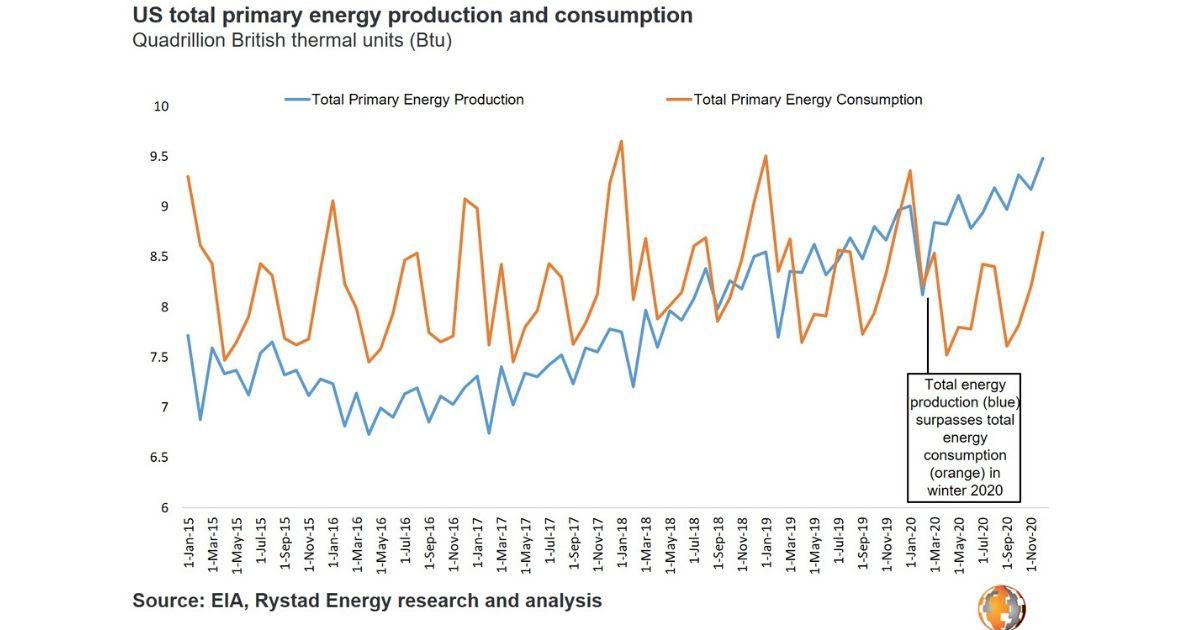US Only Months Away from Full Energy Independence

In a pivotal shift, the US is only months away from full energy independence. By 2030, total primary energy production will outpace primary energy demand by about 30%, according to Rystad Energy’s latest forecast.
“This milestone follows a strong period of growth in both hydrocarbon and renewable resources, and we forecast that the US will have primary energy surplus – and not a deficit – by February or March 2020, depending on the intensity of the winter season,” says Sindre Knutsson, vice president on Rystad Energy’s gas markets team.
“Going forward, the United States will be energy independent on a monthly basis, and by 2030 total primary energy production will outpace primary energy demand by about 30%,” Knutsson added.
Learn more about Gas Market Analytics.
 These developments are already in full swing. Rystad Energy predicts that the next monthly release from the Energy Information Agency (EIA) will reveal that the US has been self-sufficient in primary energy for a full 12-month period, from October 2018 through September 2019.
These developments are already in full swing. Rystad Energy predicts that the next monthly release from the Energy Information Agency (EIA) will reveal that the US has been self-sufficient in primary energy for a full 12-month period, from October 2018 through September 2019.
“This is the first time this will have happened since May 1982,” Knutsson observed.
This latest development spells out some broad implications on a number of fronts.
“In 2018, the United States had a petroleum deficit of $62 billion, which is equivalent to 10% of the country’s overall trade deficit of $621 billion, including goods and services. These changes in the US energy balance could turn its petroleum deficit of $62 billion in 2018 to a surplus of $340 billion by 2030. That adds up to a $400 billion shift, in the space of only a dozen years, thanks primarily to the gargantuan rise of output from the US shale sector,” Knutsson remarked.
Rystad Energy forecasts total primary energy production will increase from 95 quadrillion Btu in 2018 to 138 quadrillion Btu in 2030. Crude oil and natural gas production will be the two main contributors to primary energy supply growth in the period, with oil accounting for 75% of the growth and gas 38%. Crude output driven by production in the Permian, Bakken and Eagle Ford shale plays is forecast to grow from 21.5 quadrillion Btu (10.32 million barrels per day) in 2018 to 39 quadrillion Btu (18.73 million bpd) in 2030. The growth in natural gas production is driven by supply increases in the Marcellus, Haynesville and Utica basins, but there is also a significant amount of associated gas from the Permian, which will bring total natural gas production to 40 quadrillion Btu (about 1.1 trillion cubic meters of natural gas) in 2030 compared to 29 quadrillion Btu (0.8 Tcm of gas) in 2018.
Rystad Energy forecasts that primary energy production from renewable sources, including hydropower generation, will increase from 11.7 quadrillion Btu (3.43 trillion kilowatt hours of electricity) in 2018 to 19 quadrillion Btu (5.57 trillion kWh of electricity) in 2030. This equates to 63% growth, while growth from solar and wind is projected at about 357% and 257%, respectively. Coal production, however, is forecast to fall 37% in the same period, decreasing from 15.3 quadrillion Btu (809 million tons of coal) in 2018 to 9.6 quadrillion Btu (492 million tons) in 2030.
On the demand side, Rystad Energy forecasts a cumulative average growth of about 0.4% from 2018 to 2030, to about 106 quadrillion Btu in 2030.
“The emerging energy surplus will make the US less vulnerable to foreign energy-related politics and facilitate growing exports. While renewable energy output will be consumed domestically, the future for oil and gas exports is bright,” Knutsson remarked.
Rystad Energy’s fossil fuel energy balance shows the US was a net importer of 1.8 million barrels of oil equivalent per day (boepd) in 2018, buoyed by an especially heavy balance of imported liquids. As shale oil and gas output continues to grow, the US will import fewer barrels of oil and will increase its natural gas exports, making the country a net exporter of 0.6 million boepd of fossil fuels.
Rystad Energy forecasts that the US fossil fuel surplus will increase to 12 million boepd by 2030, thus allowing for an even larger increase in natural gas and liquids exports. In comparison, the US had a peak fossil fuel deficit of 14 million boepd in 2005.
“The growth of the shale industry will continue to revolutionize the US energy balance and create new opportunities for exports and developments in the country’s total trade balance,” Knutsson observed.

